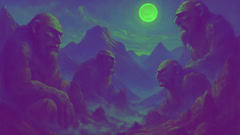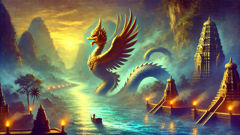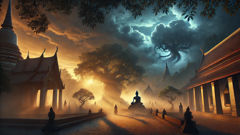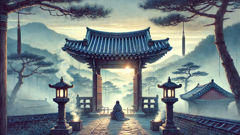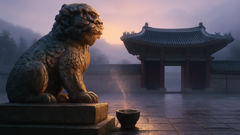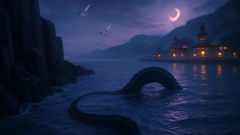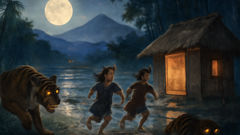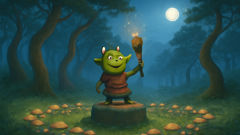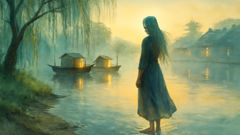Introduction
Far to the north, where Norway’s heart rises in jagged peaks and endless sky, the land folds itself into the wild realm of Jotunheimen. Here, the mountains wear ancient crowns of snow, rivers carve through stone with a slow, patient grace, and the wind tells stories older than memory. On moonless nights, shepherds and travelers hear strange echoes—a rumble like distant thunder or the heavy tread of unseen feet. For this is troll country, a place woven from legend, where the boundary between our world and something older and stranger is thin as the mountain mist.
The people of the valleys know the stories well. They pass them down by the hearth, warning children to stay close at dusk, to never follow the echoing calls that come from beyond the tree line. They speak of giants with wild hair and stone-like skin, trolls whose eyes gleam yellow in the darkness, whose laughter cracks like breaking ice. In these tales, trolls are not merely monsters—they are part of the land itself, shaping the mountains and rivers, hiding hoards of gold deep in their caverns. Their world lies hidden beneath the rocks and roots, coming alive after sundown when the sun’s protective gaze slips below the horizon.
No one knows for certain when the trolls first came to Jotunheimen. Some say they were born from the bones of the earth, as old as the glaciers themselves. Others whisper that they were gods once, cast down for their pride. Whatever their origin, the trolls hold a place at the center of Norwegian folklore, a symbol of the power and mystery that still clings to the high wild places. For as long as humans have wandered these valleys, they have wondered at the odd shapes in the rocks, the strange cairns and standing stones that seem too heavy for mortal hands to move. The answer, always, is trolls.
But there is a deeper truth in these tales—a lesson about the wild heart of nature, and the humility required to live in its shadow. For in Jotunheimen, the trolls are not merely threats; they are reminders that not everything can be tamed or understood. They hoard their treasures not out of greed, but as guardians of ancient secrets, turning to stone at the first touch of sunlight to remind us that magic is fleeting, and beauty can be dangerous. This is the story of those trolls: their world, their treasures, and the humans who dared to seek them.
The Night the Mountains Walked
Long ago, when the world was quieter and the forests deeper, there was a village called Vindre. It clung to the edge of Jotunheimen, its wooden houses huddled beneath steep cliffs as if seeking shelter from the wildness above. The people of Vindre were hardy folk—shepherds, hunters, weavers—whose lives followed the rhythm of the seasons. Yet, no matter how well they knew the land, they never truly felt at home once the sun went down.
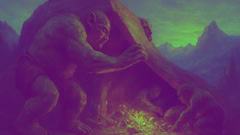
It was said that the mountains themselves moved in the darkness. Elders told of nights when entire valleys vanished or a boulder appeared where none had been before. And always, when strange things happened, there were rumors of trolls. The villagers left offerings of bread and cheese at the forest’s edge, hoping to keep the giants appeased. Children recited rhymes before bed, charms to ward off wandering eyes in the night.
One such night, with a moon so thin it could barely be seen, young Eirik—a boy of fourteen summers—sat outside his family’s cottage. He watched as fog crept up from the river and the world turned silver and silent. Eirik’s father had warned him never to linger after dark, but curiosity gnawed at him. He’d heard his grandmother speak of treasures hidden in troll caverns, and he wondered if such wonders truly existed. Tonight, he vowed, he would see for himself.
He slipped away from the warmth of his home, careful not to wake his family. The path wound steeply upward, through ancient pine and birch whose trunks were thick with lichen. Eirik’s heart thumped in his chest as the silence grew deeper, broken only by the distant call of an owl. Then, as he crested a ridge, he froze. The landscape below had changed—a valley that had always been there was gone, replaced by a lake reflecting the faint stars. He remembered his grandmother’s words: "Trolls make new lakes and valleys as easily as a child shapes clay."
Suddenly, a shadow moved among the rocks below. Eirik shrank behind a boulder, peering into the gloom. There, lumbering across the valley, was a troll. It stood twice as tall as the tallest man, its back hunched and bristling with moss and stone. Its nose was long and hooked, its eyes deep-set and glinting like wet gold. In one hand it carried a massive club; in the other, a sack that clinked with the sound of coins and jewels. Behind it trailed two smaller trolls—perhaps its kin—who argued in guttural voices, their words lost to the wind.
Eirik watched as the trolls stooped beside a cave hidden in the cliffs. The largest troll pulled a slab of stone aside with casual strength, revealing a chamber glinting with treasure. Gold spilled across the floor—rings, goblets, necklaces set with gems that caught the moonlight. The trolls muttered to one another, counting and sorting their riches with surprising care. Eirik’s breath caught in his throat. He’d never imagined such wealth could exist outside of fairy tales.
But as the night wore on, a change came over the land. A faint glow crept up from the east, and the trolls grew anxious. They hurried to finish their work, piling stones over the entrance to hide their hoard. One of the smaller trolls tripped and tumbled, sending a shower of gold rolling down the hillside. The largest troll barked a warning—too late. The first rays of dawn broke over the peaks, and the trolls turned to flee. But before they could reach the safety of their cavern, the sun touched them. In an instant, their skin hardened and cracked. The trolls froze where they stood, transformed into jagged stones that jutted from the earth, silent and still.
Eirik crept forward, trembling. The cave was sealed, but the stones marking the trolls’ final moments remained—a reminder that some secrets were not meant for mortals. He turned back toward Vindre, heart pounding with awe and fear, carrying with him the memory of what he’d seen. For years afterward, whenever travelers asked about the odd stones near the ridge, Eirik would shake his head and whisper: “Those are the trolls who didn’t make it home before dawn.”
The Troll King’s Bargain
In time, stories of Eirik’s encounter spread throughout the valleys. Some scoffed at the tale, but others grew wary of venturing too near the stones that dotted the hills. The belief that trolls walked among the peaks became woven into every part of life—guiding where shepherds grazed their flocks, where travelers built fires, even how houses were aligned so as not to catch a troll’s jealous gaze. But no tale gripped the imagination quite like the legend of the Troll King, who was said to rule beneath the highest peaks of Jotunheimen.
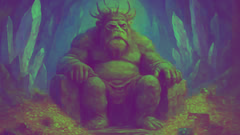
The Troll King was no ordinary giant. He was ancient beyond reckoning, his beard tangled with roots and flecks of ice, his crown fashioned from twisted branches and shards of quartz. It was whispered that he commanded not only the lesser trolls but the very rocks and storms themselves. The King’s treasure was said to be vast: gold veins deep within the mountains, silver rivers hidden below the glaciers, and gemstones that sparkled with an inner fire. No one dared seek his hoard—until the day a desperate stranger arrived in Vindre.
Her name was Astrid, and she carried with her a sorrow as heavy as any boulder. Her brother had vanished while crossing the high passes, lost to a storm that had come out of nowhere. Astrid believed that only the trolls could have caused such misfortune, and so she swore to confront them. The villagers begged her to reconsider, warning her that even the bravest hunters feared the Troll King’s wrath. But Astrid’s resolve was unshakable. With nothing but a lantern, a sharp axe, and a handful of runes carved from bone, she set off into the mountains.
The higher Astrid climbed, the wilder the world became. Winds tore at her cloak; icy streams threatened to sweep her from the path. She pressed on, following cairns she hoped marked the way. At dusk, she found herself before a cavern mouth larger than any she’d seen—a wound in the mountainside rimmed with frost and darkness. From within came a deep, echoing voice that rumbled like distant thunder: “Who dares disturb the mountain’s sleep?”
Summoning her courage, Astrid stepped inside. The cavern walls shimmered with veins of silver and crystal, casting ghostly light across the floor. At its center sat the Troll King, vast and terrible, his eyes burning like coals. Around him clustered dozens of smaller trolls—some misshapen, others almost human in form—each watching with hungry curiosity.
“I seek my brother,” Astrid called out, her voice trembling but clear. “If you have him, let him go. If you know where he lies, tell me.”
The Troll King regarded her for a long moment, then laughed—a sound that shook loose icicles from the ceiling. “Many mortals wander these mountains,” he replied. “Some are lost forever. Others bargain for what they desire. What will you offer for your brother’s life?”
Astrid reached for her axe, but the King merely smiled. “Steel cannot harm me,” he said. “But you have spirit. Perhaps that is worth something.” He gestured to a pile of treasure—rings, coins, a harp strung with golden hair. “Choose a gift, and I shall grant your request. But beware: every treasure in this hall is cursed by longing.”
Astrid hesitated. The treasures gleamed with an unearthly beauty, yet she remembered her grandmother’s words: “Troll gold turns to stone at sunrise.” Instead, she drew out her runes and cast them on the cavern floor. They tumbled and spun, landing in a pattern that spoke of hope, loss, and sacrifice.
The Troll King’s gaze softened. “You are wise,” he said. “You seek not wealth, but love.” He raised a great hand and beckoned. From behind his throne, Astrid’s brother emerged—pale and shaken but alive. “He wandered into my realm seeking shelter,” the King explained. “I kept him safe, but such mercy comes at a price.”
Astrid bowed her head. “What price?”
“Tell your people to honor the old ways,” the King replied. “Leave offerings at the mountain’s edge. Speak kindly of what you do not understand. In return, I will spare your kin from harm.”
Grateful, Astrid agreed. She led her brother home, and from that day forward, the people of Vindre renewed their respect for the trolls. Bread and cheese reappeared at the forest’s edge; songs were sung to soothe the giants’ pride. And though some still vanished in the wilds, the valleys knew peace for many years—proof that even the fiercest magic could be tempered by wisdom and humility.
When the Trolls Turned to Stone
Seasons turned as they always do, and memory faded into legend. Yet the people of Jotunheimen never forgot their uneasy truce with the trolls. Children still learned the old songs; shepherds kept watch for shadows that moved in ways no animal ever could. But there came a year when the snow lingered late and the rivers overflowed their banks—a year when the boundaries between the worlds grew thin.
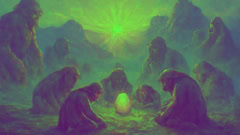
One midsummer night, as daylight clung to the peaks long after midnight, an old woman named Sigrid set out to gather wild herbs on the high slopes. Sigrid was known for her wisdom—she spoke the language of birds and read omens in the curling mists. As she picked her way through a ravine, she felt a tremor in the earth beneath her feet—a shuddering that grew into a steady, rhythmic beat.
From the mouth of a nearby cave, a procession emerged. Trolls—more than Sigrid had ever seen—marched solemnly across the mountainside, bearing torches of blue flame. At their head strode a troll maiden with hair like waterfall foam and eyes bright as glacier ice. She carried a crystal staff that glimmered in the half-light.
Sigrid hid behind a boulder and watched as the trolls gathered in a circle atop a high plateau. They began to chant, their voices weaving through the air like wind through pine needles. The earth responded—a deep vibration that seemed to pulse with the heartbeat of the mountain itself. Then, with a gesture from the troll maiden, a hidden door opened in the rock.
From within emerged something wondrous—a stone egg large enough to fill a wagon, veined with gold and humming with power. The trolls knelt before it, raising their torches in salute. Sigrid realized she was witnessing a ritual older than memory: the hatching of a new guardian for Jotunheimen.
But just as the egg began to crack and light spilled forth, a shaft of sunlight broke through the clouds. The trolls cried out in fear, scrambling for shelter. Some made it back to their cave in time, but others were caught in the sun’s golden net. In an instant, their bodies stiffened, skin turning rough and gray. Where moments before there had been life and magic, now stood only silent statues—strange and beautiful shapes forever part of the mountain.
Sigrid wept for them, understanding that even beings of great power could be undone by forces older still. She hurried home and told what she’d seen. From then on, when travelers asked about the peculiar rock formations that crowned certain ridges or huddled in lonely glens, Sigrid would tell them: “Those are the trolls who danced too long beneath the midnight sun.”
Over time, these stone trolls became landmarks—guides for wanderers, reminders of a world that once breathed with magic. And though the rituals faded as new generations grew skeptical, on certain nights when the wind howled just so, people swore they heard chanting in the darkness—a lullaby for lost giants, sung by the land itself.
Conclusion
Today, Jotunheimen remains a place of wild beauty—a land where every ridge and valley seems alive with ancient secrets. Hikers and climbers marvel at the craggy silhouettes that stand like silent sentinels across the high passes, never guessing how many are the remains of trolls caught by the sun. Locals still leave bread at crossroads, half in jest and half in hope that the old ways might still hold power. Scientists may explain the strange rocks as relics of glaciers or weathering, but in quiet moments, even skeptics feel the shiver of something uncanny in the thin mountain air.
The legend of the trolls endures not only because it entertains, but because it connects people to the land’s enduring mystery. The trolls remind us that nature is both generous and unpredictable—home to wonders and dangers that demand respect. Their treasures are not just gold and gems, but the lessons found in humility and awe. In every story passed around a campfire or whispered on a winter night, Jotunheimen’s trolls live on: guardians of Norway’s wild heart, keepers of a magic that cannot be mapped or measured, but only felt.
And so, when twilight deepens and clouds gather among the peaks, it’s easy to imagine you hear a distant laugh or glimpse a mossy brow among the stones. If you do, remember the wisdom of those who came before: honor what you do not understand, leave a gift for the unseen, and tread lightly where legends still walk.

